Exploring Recruitment and Selection Strategies for Effective HRM
VerifiedAdded on 2020/04/15
|14
|3418
|36
AI Summary
The article explores the multifaceted roles of human resources in organizations, emphasizing their significance in strategic planning and operational execution. It covers core functions such as staffing, training, performance management, and compensation, detailing recruitment and selection processes alongside innovative approaches to boost workforce efficiency. Legal compliance is underscored as essential for mitigating risks and fostering a fair work environment. The article further elaborates on motivational strategies and the importance of aligning employee goals with organizational objectives to drive success.
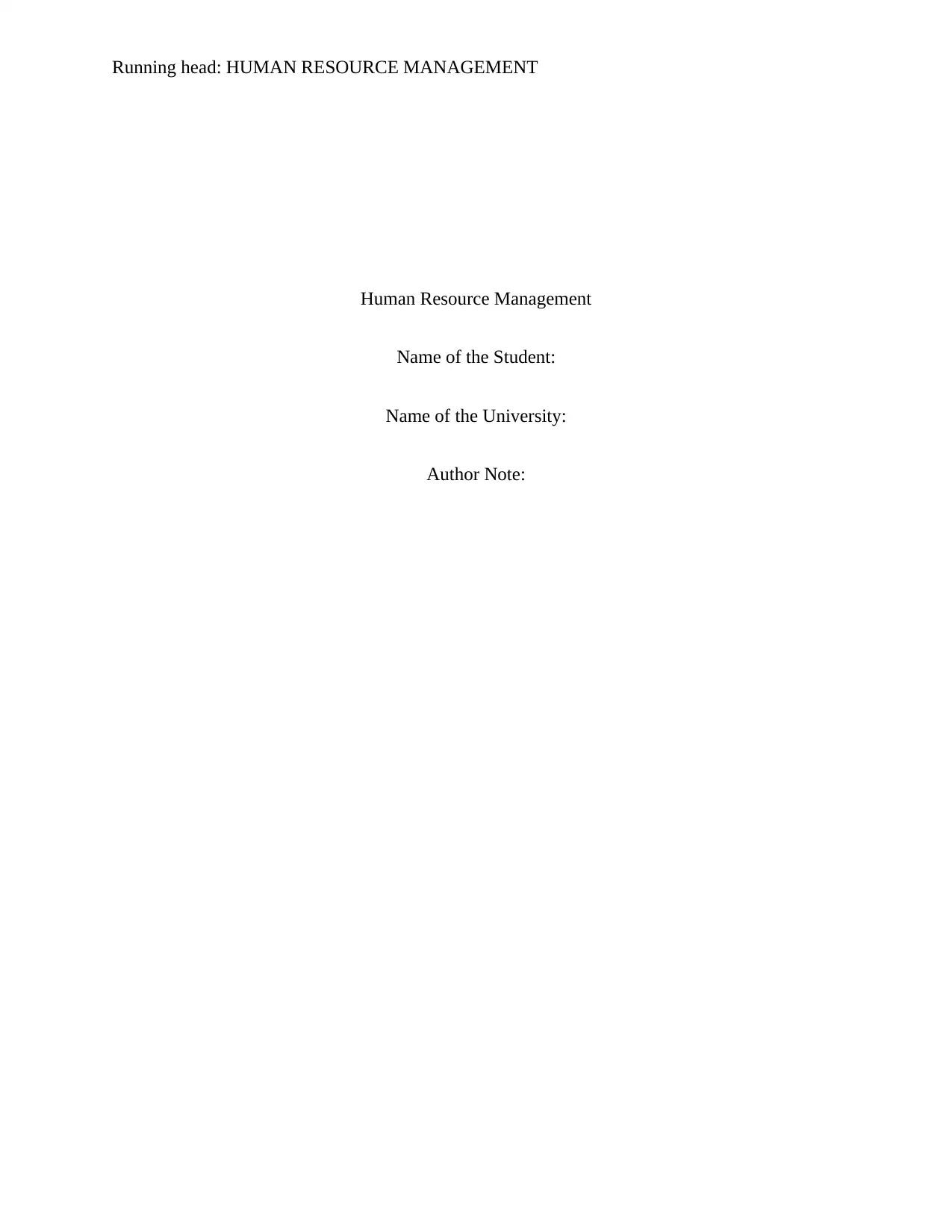
Running head: HUMAN RESOURCE MANAGEMENT
Human Resource Management
Name of the Student:
Name of the University:
Author Note:
Human Resource Management
Name of the Student:
Name of the University:
Author Note:
Paraphrase This Document
Need a fresh take? Get an instant paraphrase of this document with our AI Paraphraser
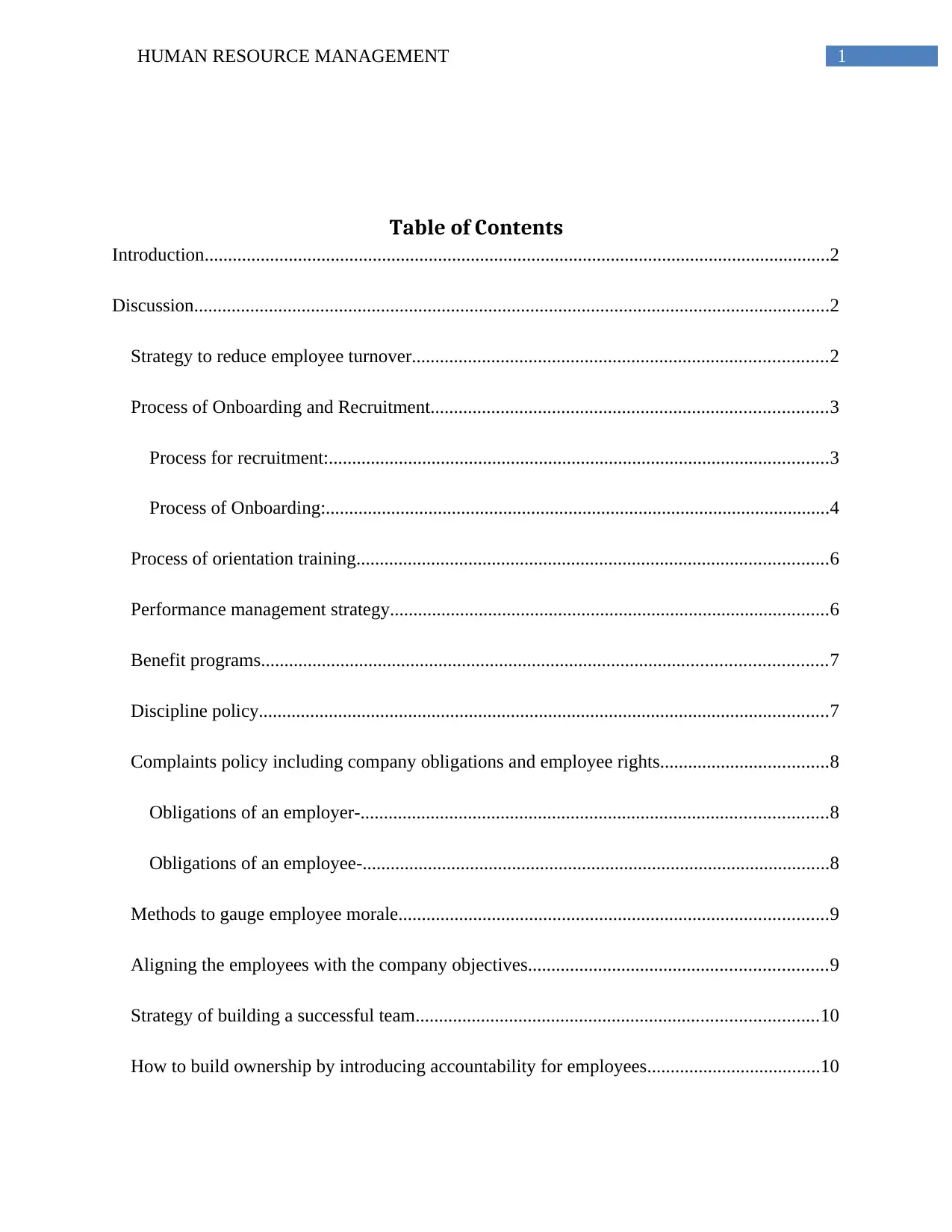
1HUMAN RESOURCE MANAGEMENT
Table of Contents
Introduction......................................................................................................................................2
Discussion........................................................................................................................................2
Strategy to reduce employee turnover.........................................................................................2
Process of Onboarding and Recruitment.....................................................................................3
Process for recruitment:...........................................................................................................3
Process of Onboarding:............................................................................................................4
Process of orientation training.....................................................................................................6
Performance management strategy..............................................................................................6
Benefit programs.........................................................................................................................7
Discipline policy..........................................................................................................................7
Complaints policy including company obligations and employee rights....................................8
Obligations of an employer-....................................................................................................8
Obligations of an employee-....................................................................................................8
Methods to gauge employee morale............................................................................................9
Aligning the employees with the company objectives................................................................9
Strategy of building a successful team......................................................................................10
How to build ownership by introducing accountability for employees.....................................10
Table of Contents
Introduction......................................................................................................................................2
Discussion........................................................................................................................................2
Strategy to reduce employee turnover.........................................................................................2
Process of Onboarding and Recruitment.....................................................................................3
Process for recruitment:...........................................................................................................3
Process of Onboarding:............................................................................................................4
Process of orientation training.....................................................................................................6
Performance management strategy..............................................................................................6
Benefit programs.........................................................................................................................7
Discipline policy..........................................................................................................................7
Complaints policy including company obligations and employee rights....................................8
Obligations of an employer-....................................................................................................8
Obligations of an employee-....................................................................................................8
Methods to gauge employee morale............................................................................................9
Aligning the employees with the company objectives................................................................9
Strategy of building a successful team......................................................................................10
How to build ownership by introducing accountability for employees.....................................10
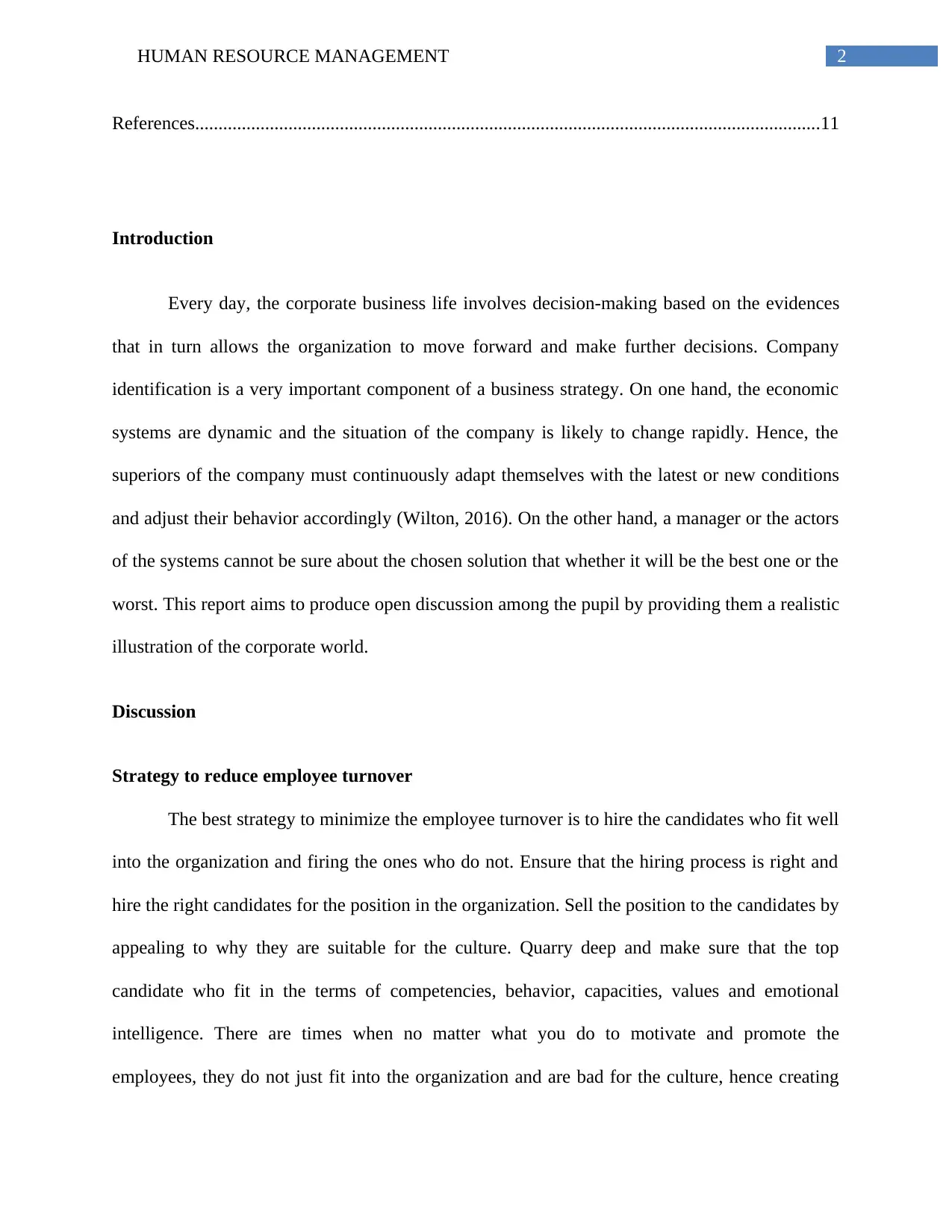
2HUMAN RESOURCE MANAGEMENT
References......................................................................................................................................11
Introduction
Every day, the corporate business life involves decision-making based on the evidences
that in turn allows the organization to move forward and make further decisions. Company
identification is a very important component of a business strategy. On one hand, the economic
systems are dynamic and the situation of the company is likely to change rapidly. Hence, the
superiors of the company must continuously adapt themselves with the latest or new conditions
and adjust their behavior accordingly (Wilton, 2016). On the other hand, a manager or the actors
of the systems cannot be sure about the chosen solution that whether it will be the best one or the
worst. This report aims to produce open discussion among the pupil by providing them a realistic
illustration of the corporate world.
Discussion
Strategy to reduce employee turnover
The best strategy to minimize the employee turnover is to hire the candidates who fit well
into the organization and firing the ones who do not. Ensure that the hiring process is right and
hire the right candidates for the position in the organization. Sell the position to the candidates by
appealing to why they are suitable for the culture. Quarry deep and make sure that the top
candidate who fit in the terms of competencies, behavior, capacities, values and emotional
intelligence. There are times when no matter what you do to motivate and promote the
employees, they do not just fit into the organization and are bad for the culture, hence creating
References......................................................................................................................................11
Introduction
Every day, the corporate business life involves decision-making based on the evidences
that in turn allows the organization to move forward and make further decisions. Company
identification is a very important component of a business strategy. On one hand, the economic
systems are dynamic and the situation of the company is likely to change rapidly. Hence, the
superiors of the company must continuously adapt themselves with the latest or new conditions
and adjust their behavior accordingly (Wilton, 2016). On the other hand, a manager or the actors
of the systems cannot be sure about the chosen solution that whether it will be the best one or the
worst. This report aims to produce open discussion among the pupil by providing them a realistic
illustration of the corporate world.
Discussion
Strategy to reduce employee turnover
The best strategy to minimize the employee turnover is to hire the candidates who fit well
into the organization and firing the ones who do not. Ensure that the hiring process is right and
hire the right candidates for the position in the organization. Sell the position to the candidates by
appealing to why they are suitable for the culture. Quarry deep and make sure that the top
candidate who fit in the terms of competencies, behavior, capacities, values and emotional
intelligence. There are times when no matter what you do to motivate and promote the
employees, they do not just fit into the organization and are bad for the culture, hence creating
⊘ This is a preview!⊘
Do you want full access?
Subscribe today to unlock all pages.

Trusted by 1+ million students worldwide
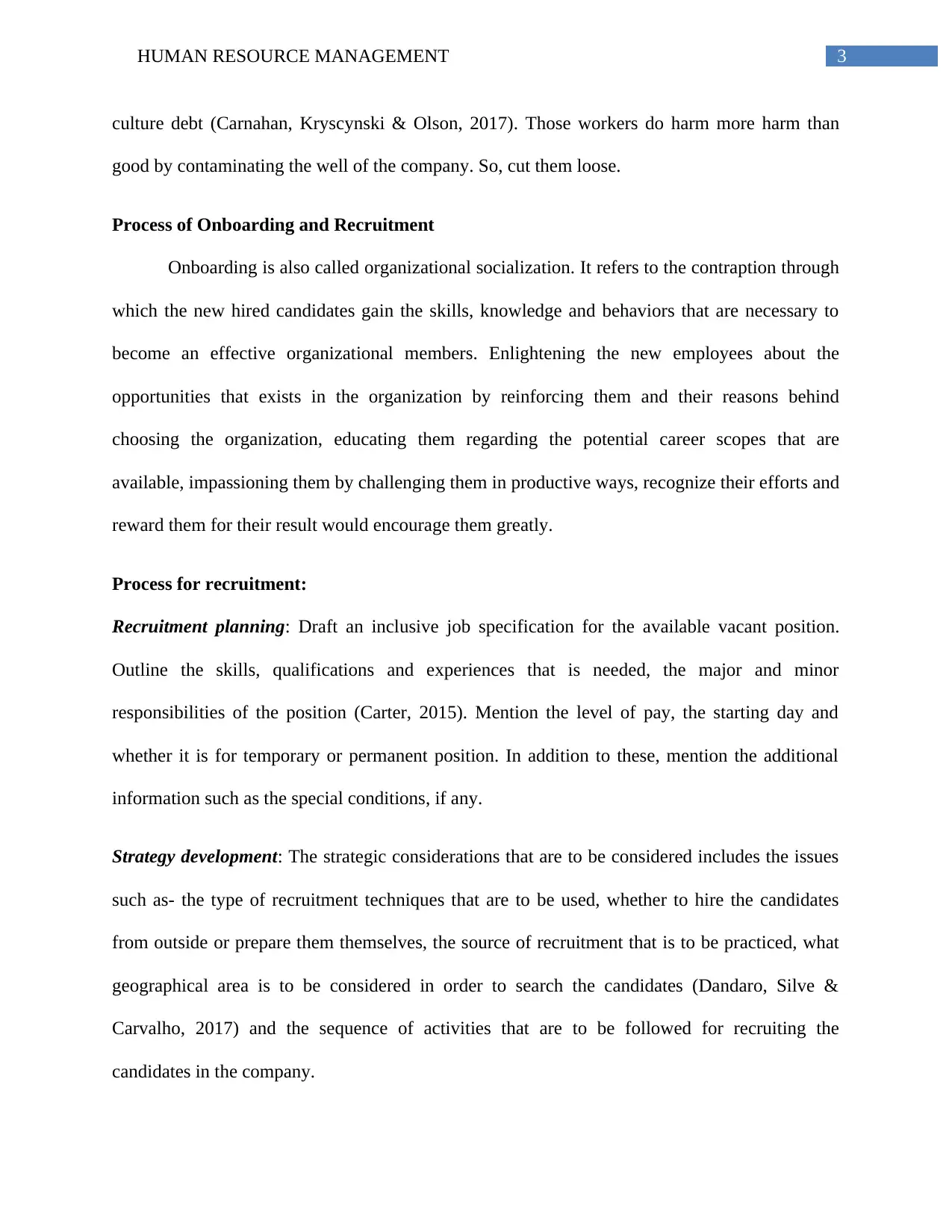
3HUMAN RESOURCE MANAGEMENT
culture debt (Carnahan, Kryscynski & Olson, 2017). Those workers do harm more harm than
good by contaminating the well of the company. So, cut them loose.
Process of Onboarding and Recruitment
Onboarding is also called organizational socialization. It refers to the contraption through
which the new hired candidates gain the skills, knowledge and behaviors that are necessary to
become an effective organizational members. Enlightening the new employees about the
opportunities that exists in the organization by reinforcing them and their reasons behind
choosing the organization, educating them regarding the potential career scopes that are
available, impassioning them by challenging them in productive ways, recognize their efforts and
reward them for their result would encourage them greatly.
Process for recruitment:
Recruitment planning: Draft an inclusive job specification for the available vacant position.
Outline the skills, qualifications and experiences that is needed, the major and minor
responsibilities of the position (Carter, 2015). Mention the level of pay, the starting day and
whether it is for temporary or permanent position. In addition to these, mention the additional
information such as the special conditions, if any.
Strategy development: The strategic considerations that are to be considered includes the issues
such as- the type of recruitment techniques that are to be used, whether to hire the candidates
from outside or prepare them themselves, the source of recruitment that is to be practiced, what
geographical area is to be considered in order to search the candidates (Dandaro, Silve &
Carvalho, 2017) and the sequence of activities that are to be followed for recruiting the
candidates in the company.
culture debt (Carnahan, Kryscynski & Olson, 2017). Those workers do harm more harm than
good by contaminating the well of the company. So, cut them loose.
Process of Onboarding and Recruitment
Onboarding is also called organizational socialization. It refers to the contraption through
which the new hired candidates gain the skills, knowledge and behaviors that are necessary to
become an effective organizational members. Enlightening the new employees about the
opportunities that exists in the organization by reinforcing them and their reasons behind
choosing the organization, educating them regarding the potential career scopes that are
available, impassioning them by challenging them in productive ways, recognize their efforts and
reward them for their result would encourage them greatly.
Process for recruitment:
Recruitment planning: Draft an inclusive job specification for the available vacant position.
Outline the skills, qualifications and experiences that is needed, the major and minor
responsibilities of the position (Carter, 2015). Mention the level of pay, the starting day and
whether it is for temporary or permanent position. In addition to these, mention the additional
information such as the special conditions, if any.
Strategy development: The strategic considerations that are to be considered includes the issues
such as- the type of recruitment techniques that are to be used, whether to hire the candidates
from outside or prepare them themselves, the source of recruitment that is to be practiced, what
geographical area is to be considered in order to search the candidates (Dandaro, Silve &
Carvalho, 2017) and the sequence of activities that are to be followed for recruiting the
candidates in the company.
Paraphrase This Document
Need a fresh take? Get an instant paraphrase of this document with our AI Paraphraser
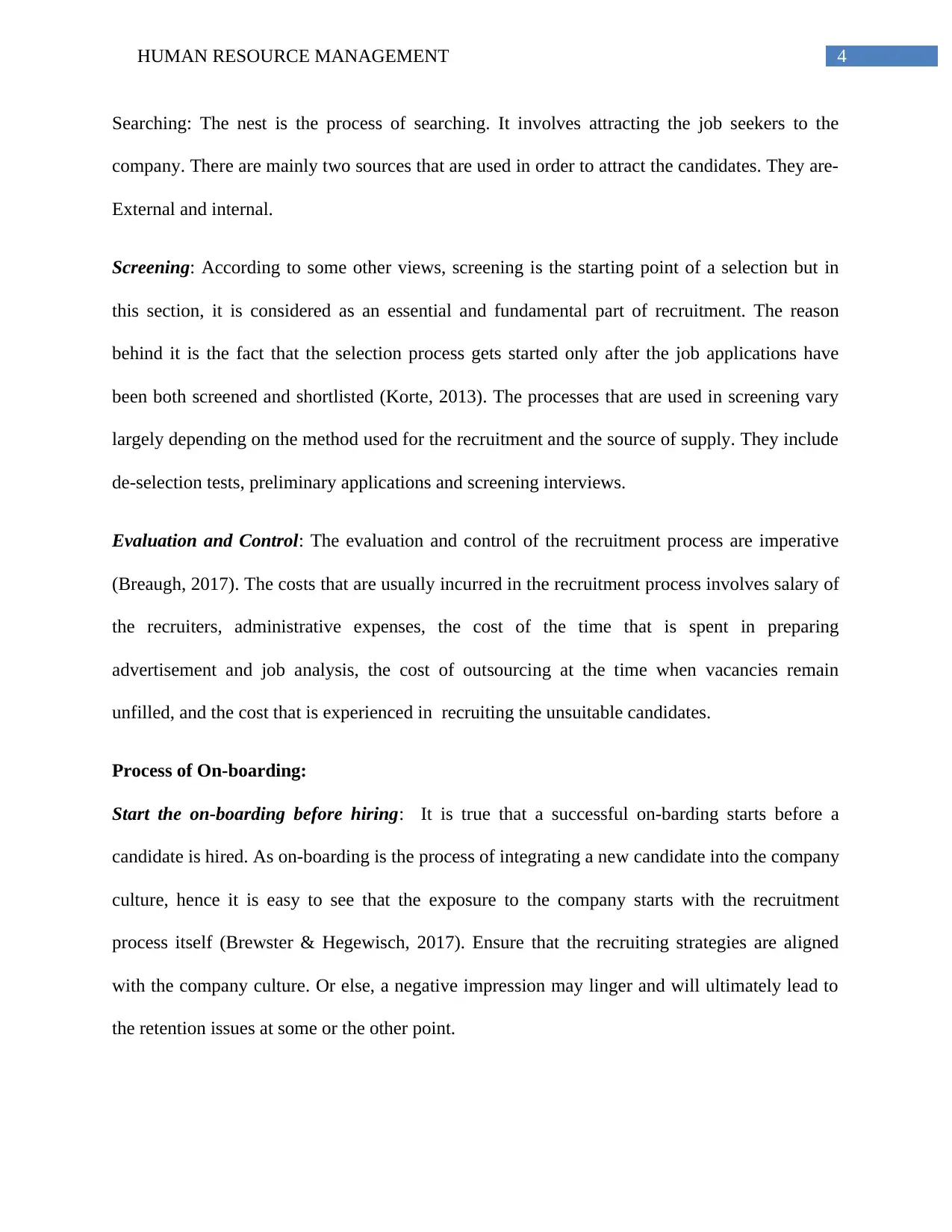
4HUMAN RESOURCE MANAGEMENT
Searching: The nest is the process of searching. It involves attracting the job seekers to the
company. There are mainly two sources that are used in order to attract the candidates. They are-
External and internal.
Screening: According to some other views, screening is the starting point of a selection but in
this section, it is considered as an essential and fundamental part of recruitment. The reason
behind it is the fact that the selection process gets started only after the job applications have
been both screened and shortlisted (Korte, 2013). The processes that are used in screening vary
largely depending on the method used for the recruitment and the source of supply. They include
de-selection tests, preliminary applications and screening interviews.
Evaluation and Control: The evaluation and control of the recruitment process are imperative
(Breaugh, 2017). The costs that are usually incurred in the recruitment process involves salary of
the recruiters, administrative expenses, the cost of the time that is spent in preparing
advertisement and job analysis, the cost of outsourcing at the time when vacancies remain
unfilled, and the cost that is experienced in recruiting the unsuitable candidates.
Process of On-boarding:
Start the on-boarding before hiring: It is true that a successful on-barding starts before a
candidate is hired. As on-boarding is the process of integrating a new candidate into the company
culture, hence it is easy to see that the exposure to the company starts with the recruitment
process itself (Brewster & Hegewisch, 2017). Ensure that the recruiting strategies are aligned
with the company culture. Or else, a negative impression may linger and will ultimately lead to
the retention issues at some or the other point.
Searching: The nest is the process of searching. It involves attracting the job seekers to the
company. There are mainly two sources that are used in order to attract the candidates. They are-
External and internal.
Screening: According to some other views, screening is the starting point of a selection but in
this section, it is considered as an essential and fundamental part of recruitment. The reason
behind it is the fact that the selection process gets started only after the job applications have
been both screened and shortlisted (Korte, 2013). The processes that are used in screening vary
largely depending on the method used for the recruitment and the source of supply. They include
de-selection tests, preliminary applications and screening interviews.
Evaluation and Control: The evaluation and control of the recruitment process are imperative
(Breaugh, 2017). The costs that are usually incurred in the recruitment process involves salary of
the recruiters, administrative expenses, the cost of the time that is spent in preparing
advertisement and job analysis, the cost of outsourcing at the time when vacancies remain
unfilled, and the cost that is experienced in recruiting the unsuitable candidates.
Process of On-boarding:
Start the on-boarding before hiring: It is true that a successful on-barding starts before a
candidate is hired. As on-boarding is the process of integrating a new candidate into the company
culture, hence it is easy to see that the exposure to the company starts with the recruitment
process itself (Brewster & Hegewisch, 2017). Ensure that the recruiting strategies are aligned
with the company culture. Or else, a negative impression may linger and will ultimately lead to
the retention issues at some or the other point.
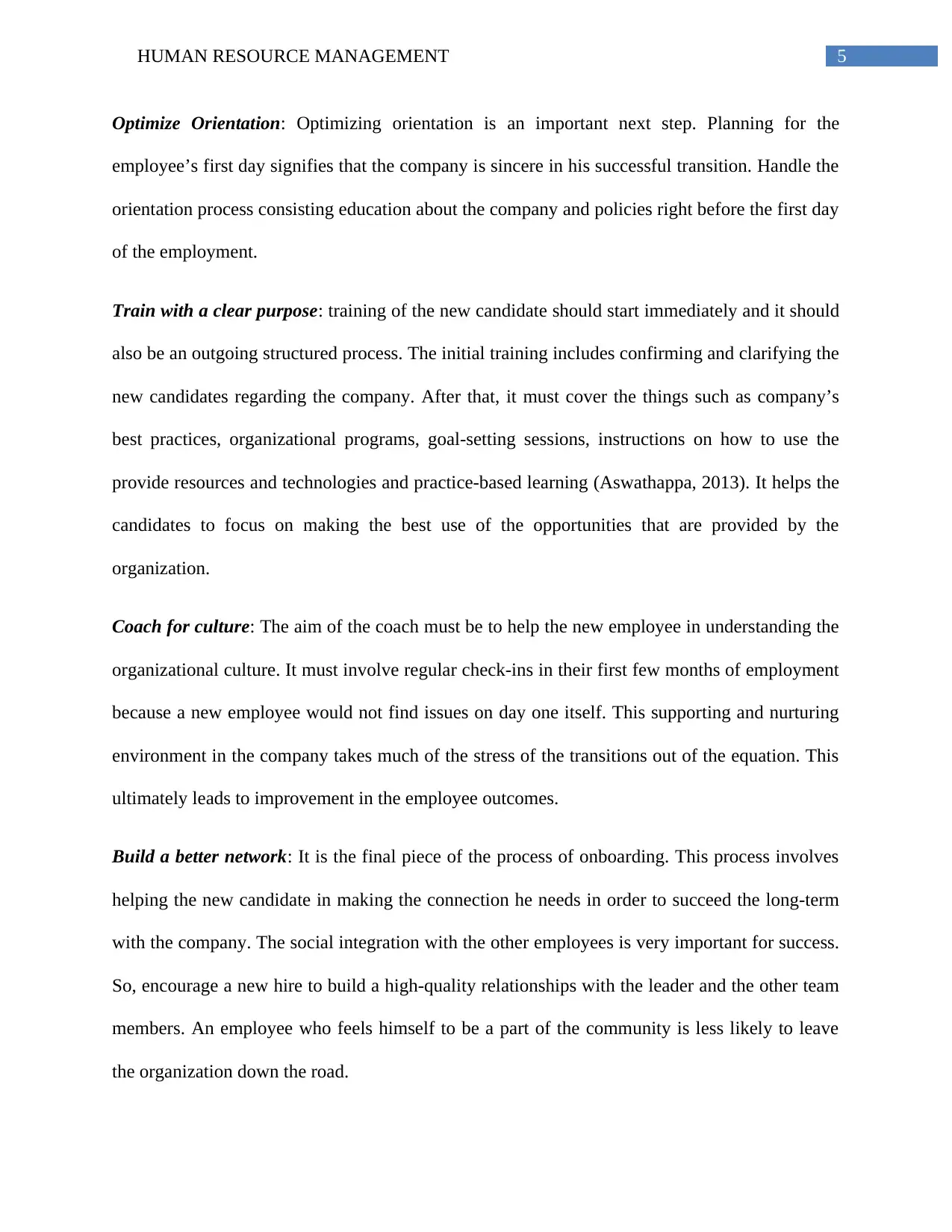
5HUMAN RESOURCE MANAGEMENT
Optimize Orientation: Optimizing orientation is an important next step. Planning for the
employee’s first day signifies that the company is sincere in his successful transition. Handle the
orientation process consisting education about the company and policies right before the first day
of the employment.
Train with a clear purpose: training of the new candidate should start immediately and it should
also be an outgoing structured process. The initial training includes confirming and clarifying the
new candidates regarding the company. After that, it must cover the things such as company’s
best practices, organizational programs, goal-setting sessions, instructions on how to use the
provide resources and technologies and practice-based learning (Aswathappa, 2013). It helps the
candidates to focus on making the best use of the opportunities that are provided by the
organization.
Coach for culture: The aim of the coach must be to help the new employee in understanding the
organizational culture. It must involve regular check-ins in their first few months of employment
because a new employee would not find issues on day one itself. This supporting and nurturing
environment in the company takes much of the stress of the transitions out of the equation. This
ultimately leads to improvement in the employee outcomes.
Build a better network: It is the final piece of the process of onboarding. This process involves
helping the new candidate in making the connection he needs in order to succeed the long-term
with the company. The social integration with the other employees is very important for success.
So, encourage a new hire to build a high-quality relationships with the leader and the other team
members. An employee who feels himself to be a part of the community is less likely to leave
the organization down the road.
Optimize Orientation: Optimizing orientation is an important next step. Planning for the
employee’s first day signifies that the company is sincere in his successful transition. Handle the
orientation process consisting education about the company and policies right before the first day
of the employment.
Train with a clear purpose: training of the new candidate should start immediately and it should
also be an outgoing structured process. The initial training includes confirming and clarifying the
new candidates regarding the company. After that, it must cover the things such as company’s
best practices, organizational programs, goal-setting sessions, instructions on how to use the
provide resources and technologies and practice-based learning (Aswathappa, 2013). It helps the
candidates to focus on making the best use of the opportunities that are provided by the
organization.
Coach for culture: The aim of the coach must be to help the new employee in understanding the
organizational culture. It must involve regular check-ins in their first few months of employment
because a new employee would not find issues on day one itself. This supporting and nurturing
environment in the company takes much of the stress of the transitions out of the equation. This
ultimately leads to improvement in the employee outcomes.
Build a better network: It is the final piece of the process of onboarding. This process involves
helping the new candidate in making the connection he needs in order to succeed the long-term
with the company. The social integration with the other employees is very important for success.
So, encourage a new hire to build a high-quality relationships with the leader and the other team
members. An employee who feels himself to be a part of the community is less likely to leave
the organization down the road.
⊘ This is a preview!⊘
Do you want full access?
Subscribe today to unlock all pages.

Trusted by 1+ million students worldwide
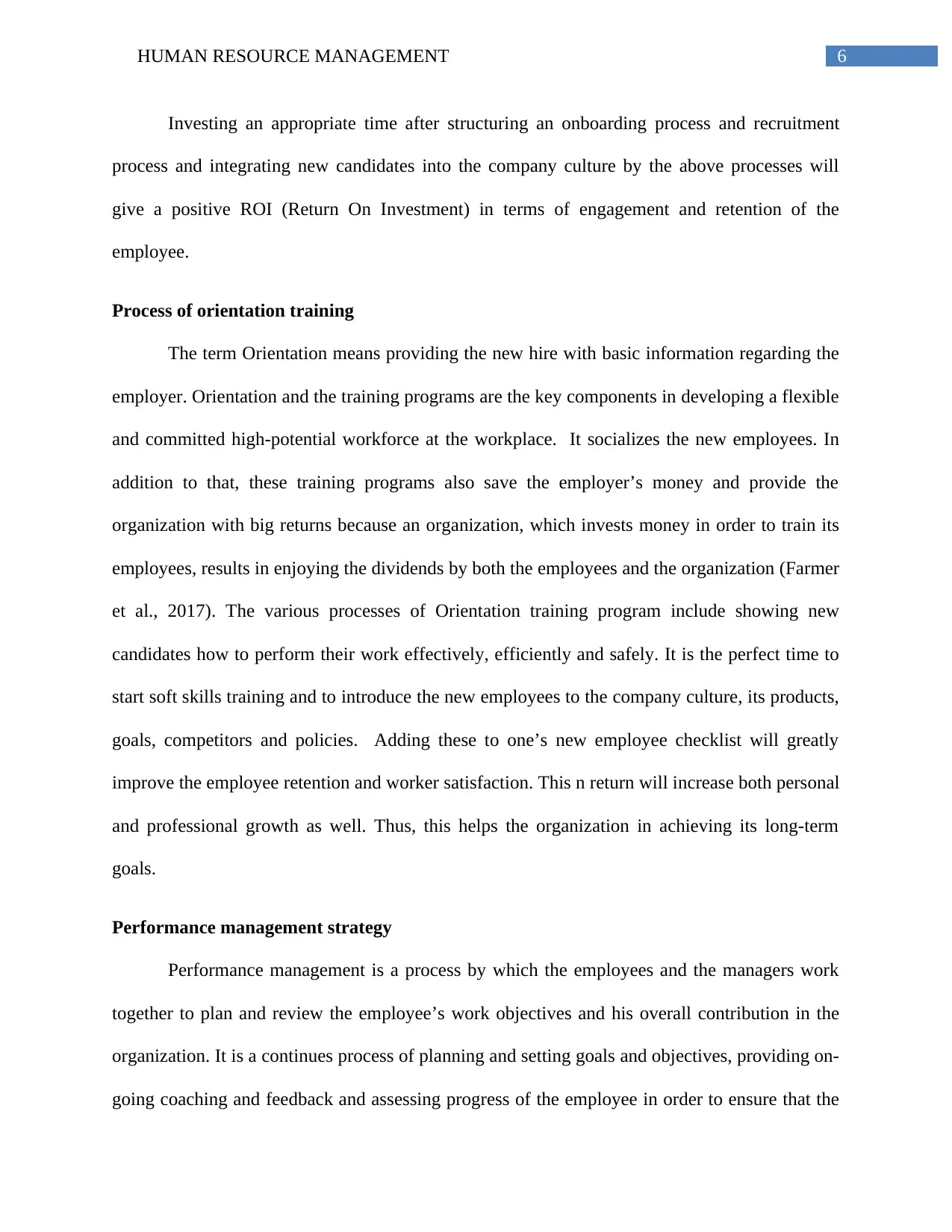
6HUMAN RESOURCE MANAGEMENT
Investing an appropriate time after structuring an onboarding process and recruitment
process and integrating new candidates into the company culture by the above processes will
give a positive ROI (Return On Investment) in terms of engagement and retention of the
employee.
Process of orientation training
The term Orientation means providing the new hire with basic information regarding the
employer. Orientation and the training programs are the key components in developing a flexible
and committed high-potential workforce at the workplace. It socializes the new employees. In
addition to that, these training programs also save the employer’s money and provide the
organization with big returns because an organization, which invests money in order to train its
employees, results in enjoying the dividends by both the employees and the organization (Farmer
et al., 2017). The various processes of Orientation training program include showing new
candidates how to perform their work effectively, efficiently and safely. It is the perfect time to
start soft skills training and to introduce the new employees to the company culture, its products,
goals, competitors and policies. Adding these to one’s new employee checklist will greatly
improve the employee retention and worker satisfaction. This n return will increase both personal
and professional growth as well. Thus, this helps the organization in achieving its long-term
goals.
Performance management strategy
Performance management is a process by which the employees and the managers work
together to plan and review the employee’s work objectives and his overall contribution in the
organization. It is a continues process of planning and setting goals and objectives, providing on-
going coaching and feedback and assessing progress of the employee in order to ensure that the
Investing an appropriate time after structuring an onboarding process and recruitment
process and integrating new candidates into the company culture by the above processes will
give a positive ROI (Return On Investment) in terms of engagement and retention of the
employee.
Process of orientation training
The term Orientation means providing the new hire with basic information regarding the
employer. Orientation and the training programs are the key components in developing a flexible
and committed high-potential workforce at the workplace. It socializes the new employees. In
addition to that, these training programs also save the employer’s money and provide the
organization with big returns because an organization, which invests money in order to train its
employees, results in enjoying the dividends by both the employees and the organization (Farmer
et al., 2017). The various processes of Orientation training program include showing new
candidates how to perform their work effectively, efficiently and safely. It is the perfect time to
start soft skills training and to introduce the new employees to the company culture, its products,
goals, competitors and policies. Adding these to one’s new employee checklist will greatly
improve the employee retention and worker satisfaction. This n return will increase both personal
and professional growth as well. Thus, this helps the organization in achieving its long-term
goals.
Performance management strategy
Performance management is a process by which the employees and the managers work
together to plan and review the employee’s work objectives and his overall contribution in the
organization. It is a continues process of planning and setting goals and objectives, providing on-
going coaching and feedback and assessing progress of the employee in order to ensure that the
Paraphrase This Document
Need a fresh take? Get an instant paraphrase of this document with our AI Paraphraser
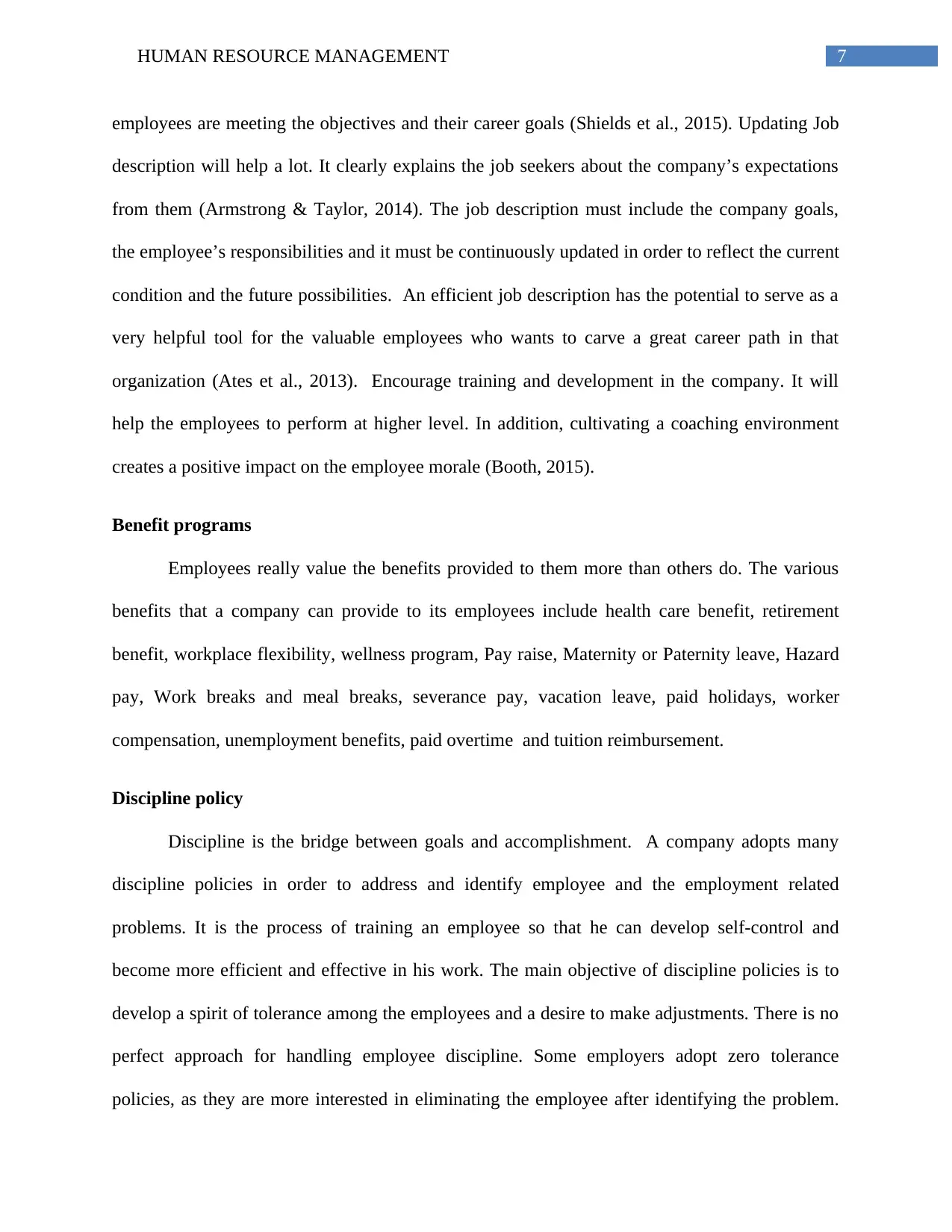
7HUMAN RESOURCE MANAGEMENT
employees are meeting the objectives and their career goals (Shields et al., 2015). Updating Job
description will help a lot. It clearly explains the job seekers about the company’s expectations
from them (Armstrong & Taylor, 2014). The job description must include the company goals,
the employee’s responsibilities and it must be continuously updated in order to reflect the current
condition and the future possibilities. An efficient job description has the potential to serve as a
very helpful tool for the valuable employees who wants to carve a great career path in that
organization (Ates et al., 2013). Encourage training and development in the company. It will
help the employees to perform at higher level. In addition, cultivating a coaching environment
creates a positive impact on the employee morale (Booth, 2015).
Benefit programs
Employees really value the benefits provided to them more than others do. The various
benefits that a company can provide to its employees include health care benefit, retirement
benefit, workplace flexibility, wellness program, Pay raise, Maternity or Paternity leave, Hazard
pay, Work breaks and meal breaks, severance pay, vacation leave, paid holidays, worker
compensation, unemployment benefits, paid overtime and tuition reimbursement.
Discipline policy
Discipline is the bridge between goals and accomplishment. A company adopts many
discipline policies in order to address and identify employee and the employment related
problems. It is the process of training an employee so that he can develop self-control and
become more efficient and effective in his work. The main objective of discipline policies is to
develop a spirit of tolerance among the employees and a desire to make adjustments. There is no
perfect approach for handling employee discipline. Some employers adopt zero tolerance
policies, as they are more interested in eliminating the employee after identifying the problem.
employees are meeting the objectives and their career goals (Shields et al., 2015). Updating Job
description will help a lot. It clearly explains the job seekers about the company’s expectations
from them (Armstrong & Taylor, 2014). The job description must include the company goals,
the employee’s responsibilities and it must be continuously updated in order to reflect the current
condition and the future possibilities. An efficient job description has the potential to serve as a
very helpful tool for the valuable employees who wants to carve a great career path in that
organization (Ates et al., 2013). Encourage training and development in the company. It will
help the employees to perform at higher level. In addition, cultivating a coaching environment
creates a positive impact on the employee morale (Booth, 2015).
Benefit programs
Employees really value the benefits provided to them more than others do. The various
benefits that a company can provide to its employees include health care benefit, retirement
benefit, workplace flexibility, wellness program, Pay raise, Maternity or Paternity leave, Hazard
pay, Work breaks and meal breaks, severance pay, vacation leave, paid holidays, worker
compensation, unemployment benefits, paid overtime and tuition reimbursement.
Discipline policy
Discipline is the bridge between goals and accomplishment. A company adopts many
discipline policies in order to address and identify employee and the employment related
problems. It is the process of training an employee so that he can develop self-control and
become more efficient and effective in his work. The main objective of discipline policies is to
develop a spirit of tolerance among the employees and a desire to make adjustments. There is no
perfect approach for handling employee discipline. Some employers adopt zero tolerance
policies, as they are more interested in eliminating the employee after identifying the problem.
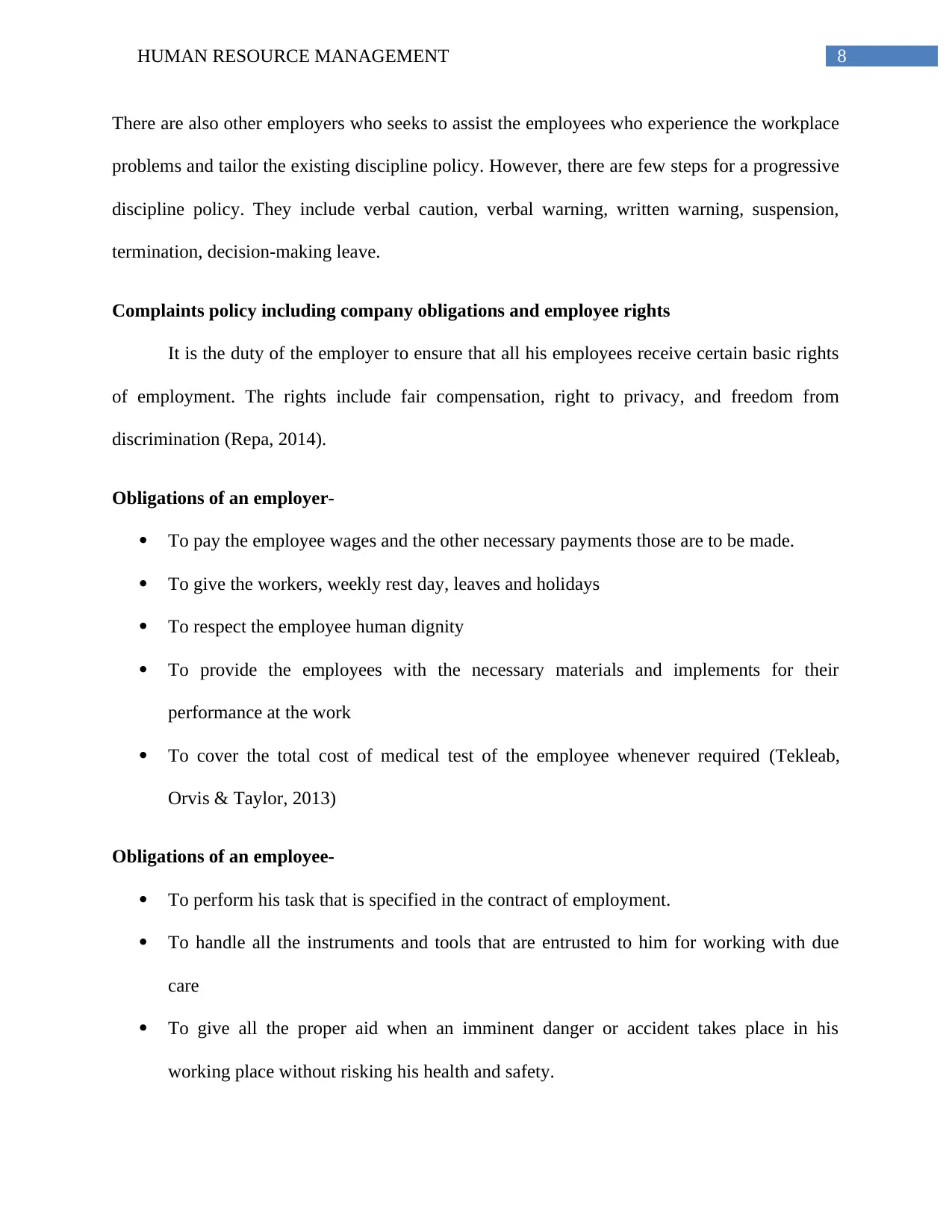
8HUMAN RESOURCE MANAGEMENT
There are also other employers who seeks to assist the employees who experience the workplace
problems and tailor the existing discipline policy. However, there are few steps for a progressive
discipline policy. They include verbal caution, verbal warning, written warning, suspension,
termination, decision-making leave.
Complaints policy including company obligations and employee rights
It is the duty of the employer to ensure that all his employees receive certain basic rights
of employment. The rights include fair compensation, right to privacy, and freedom from
discrimination (Repa, 2014).
Obligations of an employer-
To pay the employee wages and the other necessary payments those are to be made.
To give the workers, weekly rest day, leaves and holidays
To respect the employee human dignity
To provide the employees with the necessary materials and implements for their
performance at the work
To cover the total cost of medical test of the employee whenever required (Tekleab,
Orvis & Taylor, 2013)
Obligations of an employee-
To perform his task that is specified in the contract of employment.
To handle all the instruments and tools that are entrusted to him for working with due
care
To give all the proper aid when an imminent danger or accident takes place in his
working place without risking his health and safety.
There are also other employers who seeks to assist the employees who experience the workplace
problems and tailor the existing discipline policy. However, there are few steps for a progressive
discipline policy. They include verbal caution, verbal warning, written warning, suspension,
termination, decision-making leave.
Complaints policy including company obligations and employee rights
It is the duty of the employer to ensure that all his employees receive certain basic rights
of employment. The rights include fair compensation, right to privacy, and freedom from
discrimination (Repa, 2014).
Obligations of an employer-
To pay the employee wages and the other necessary payments those are to be made.
To give the workers, weekly rest day, leaves and holidays
To respect the employee human dignity
To provide the employees with the necessary materials and implements for their
performance at the work
To cover the total cost of medical test of the employee whenever required (Tekleab,
Orvis & Taylor, 2013)
Obligations of an employee-
To perform his task that is specified in the contract of employment.
To handle all the instruments and tools that are entrusted to him for working with due
care
To give all the proper aid when an imminent danger or accident takes place in his
working place without risking his health and safety.
⊘ This is a preview!⊘
Do you want full access?
Subscribe today to unlock all pages.

Trusted by 1+ million students worldwide
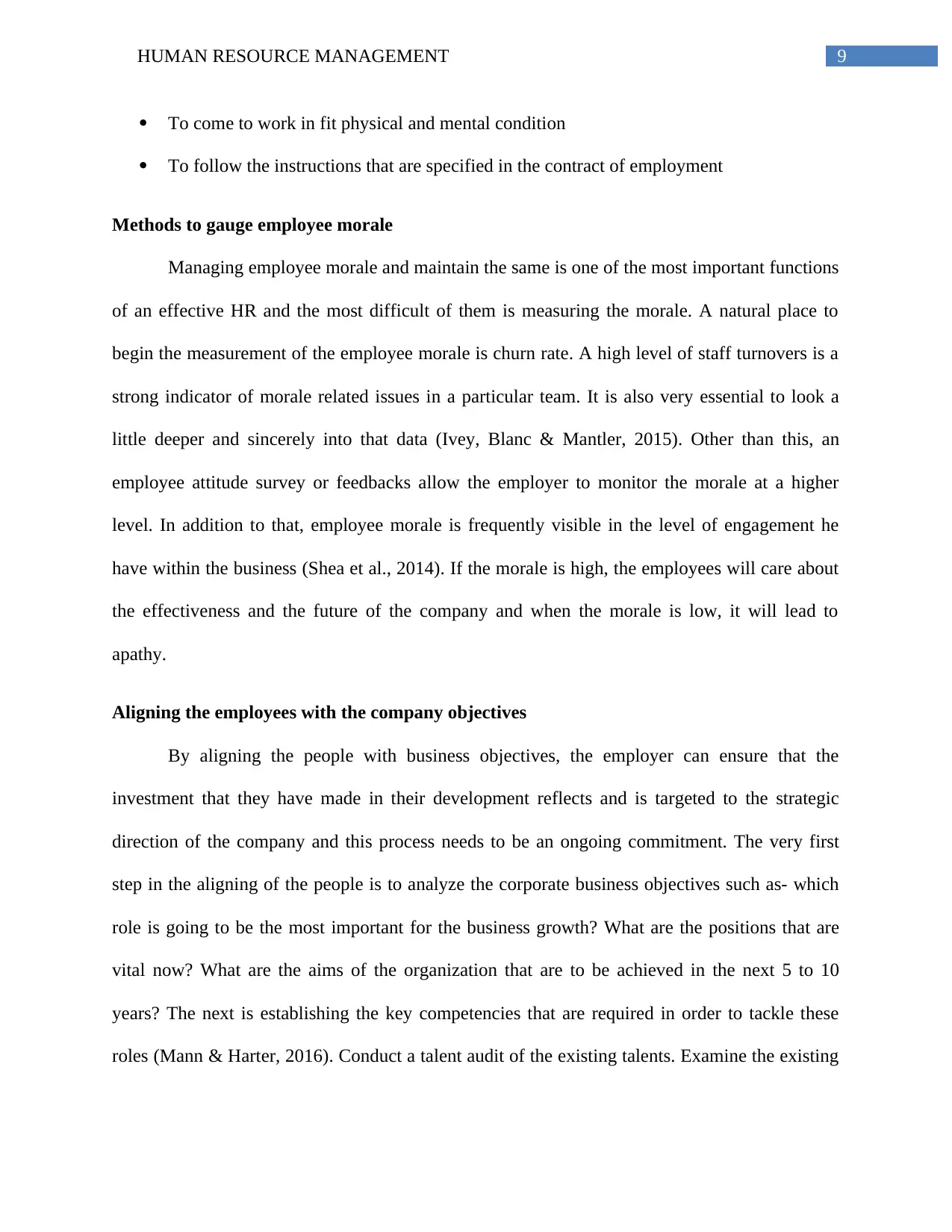
9HUMAN RESOURCE MANAGEMENT
To come to work in fit physical and mental condition
To follow the instructions that are specified in the contract of employment
Methods to gauge employee morale
Managing employee morale and maintain the same is one of the most important functions
of an effective HR and the most difficult of them is measuring the morale. A natural place to
begin the measurement of the employee morale is churn rate. A high level of staff turnovers is a
strong indicator of morale related issues in a particular team. It is also very essential to look a
little deeper and sincerely into that data (Ivey, Blanc & Mantler, 2015). Other than this, an
employee attitude survey or feedbacks allow the employer to monitor the morale at a higher
level. In addition to that, employee morale is frequently visible in the level of engagement he
have within the business (Shea et al., 2014). If the morale is high, the employees will care about
the effectiveness and the future of the company and when the morale is low, it will lead to
apathy.
Aligning the employees with the company objectives
By aligning the people with business objectives, the employer can ensure that the
investment that they have made in their development reflects and is targeted to the strategic
direction of the company and this process needs to be an ongoing commitment. The very first
step in the aligning of the people is to analyze the corporate business objectives such as- which
role is going to be the most important for the business growth? What are the positions that are
vital now? What are the aims of the organization that are to be achieved in the next 5 to 10
years? The next is establishing the key competencies that are required in order to tackle these
roles (Mann & Harter, 2016). Conduct a talent audit of the existing talents. Examine the existing
To come to work in fit physical and mental condition
To follow the instructions that are specified in the contract of employment
Methods to gauge employee morale
Managing employee morale and maintain the same is one of the most important functions
of an effective HR and the most difficult of them is measuring the morale. A natural place to
begin the measurement of the employee morale is churn rate. A high level of staff turnovers is a
strong indicator of morale related issues in a particular team. It is also very essential to look a
little deeper and sincerely into that data (Ivey, Blanc & Mantler, 2015). Other than this, an
employee attitude survey or feedbacks allow the employer to monitor the morale at a higher
level. In addition to that, employee morale is frequently visible in the level of engagement he
have within the business (Shea et al., 2014). If the morale is high, the employees will care about
the effectiveness and the future of the company and when the morale is low, it will lead to
apathy.
Aligning the employees with the company objectives
By aligning the people with business objectives, the employer can ensure that the
investment that they have made in their development reflects and is targeted to the strategic
direction of the company and this process needs to be an ongoing commitment. The very first
step in the aligning of the people is to analyze the corporate business objectives such as- which
role is going to be the most important for the business growth? What are the positions that are
vital now? What are the aims of the organization that are to be achieved in the next 5 to 10
years? The next is establishing the key competencies that are required in order to tackle these
roles (Mann & Harter, 2016). Conduct a talent audit of the existing talents. Examine the existing
Paraphrase This Document
Need a fresh take? Get an instant paraphrase of this document with our AI Paraphraser
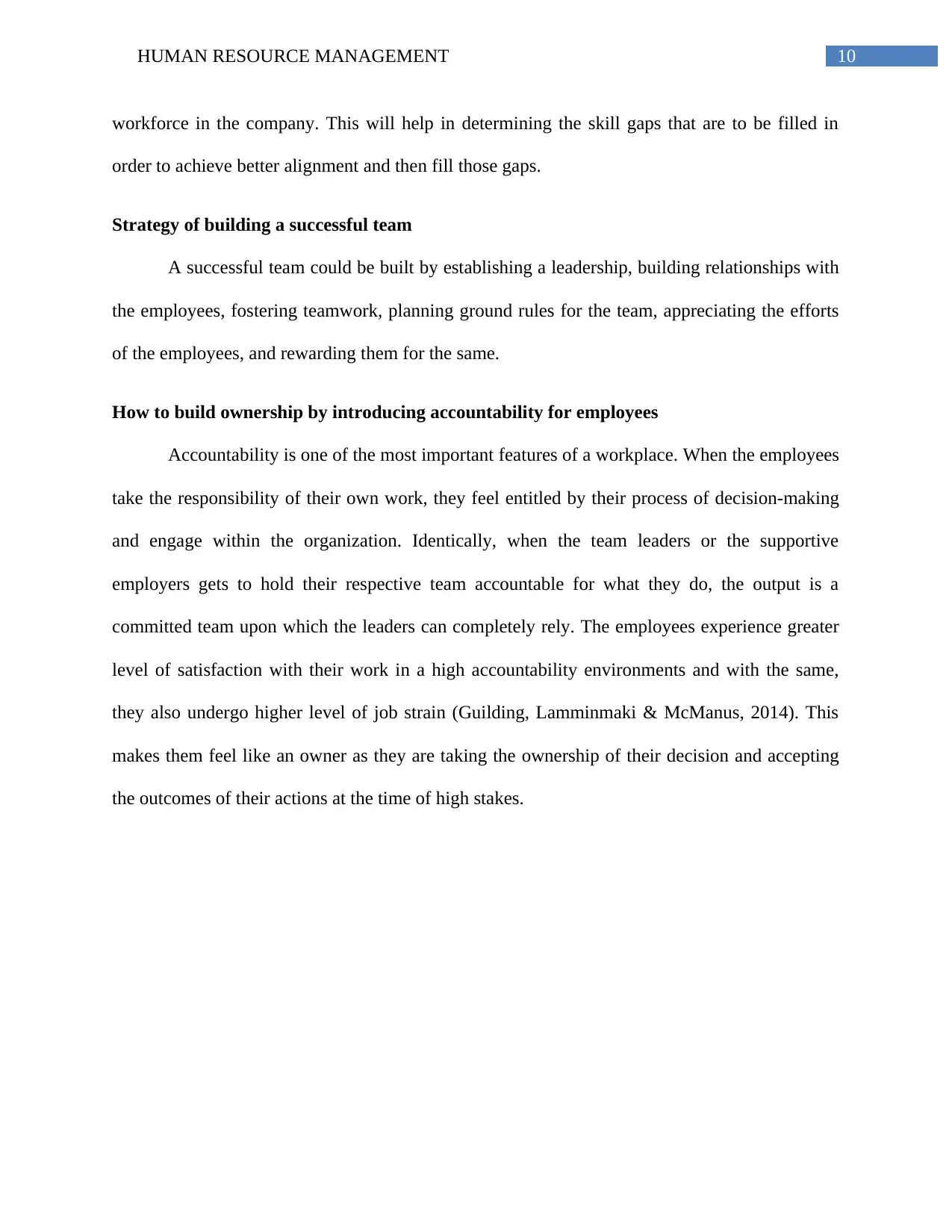
10HUMAN RESOURCE MANAGEMENT
workforce in the company. This will help in determining the skill gaps that are to be filled in
order to achieve better alignment and then fill those gaps.
Strategy of building a successful team
A successful team could be built by establishing a leadership, building relationships with
the employees, fostering teamwork, planning ground rules for the team, appreciating the efforts
of the employees, and rewarding them for the same.
How to build ownership by introducing accountability for employees
Accountability is one of the most important features of a workplace. When the employees
take the responsibility of their own work, they feel entitled by their process of decision-making
and engage within the organization. Identically, when the team leaders or the supportive
employers gets to hold their respective team accountable for what they do, the output is a
committed team upon which the leaders can completely rely. The employees experience greater
level of satisfaction with their work in a high accountability environments and with the same,
they also undergo higher level of job strain (Guilding, Lamminmaki & McManus, 2014). This
makes them feel like an owner as they are taking the ownership of their decision and accepting
the outcomes of their actions at the time of high stakes.
workforce in the company. This will help in determining the skill gaps that are to be filled in
order to achieve better alignment and then fill those gaps.
Strategy of building a successful team
A successful team could be built by establishing a leadership, building relationships with
the employees, fostering teamwork, planning ground rules for the team, appreciating the efforts
of the employees, and rewarding them for the same.
How to build ownership by introducing accountability for employees
Accountability is one of the most important features of a workplace. When the employees
take the responsibility of their own work, they feel entitled by their process of decision-making
and engage within the organization. Identically, when the team leaders or the supportive
employers gets to hold their respective team accountable for what they do, the output is a
committed team upon which the leaders can completely rely. The employees experience greater
level of satisfaction with their work in a high accountability environments and with the same,
they also undergo higher level of job strain (Guilding, Lamminmaki & McManus, 2014). This
makes them feel like an owner as they are taking the ownership of their decision and accepting
the outcomes of their actions at the time of high stakes.
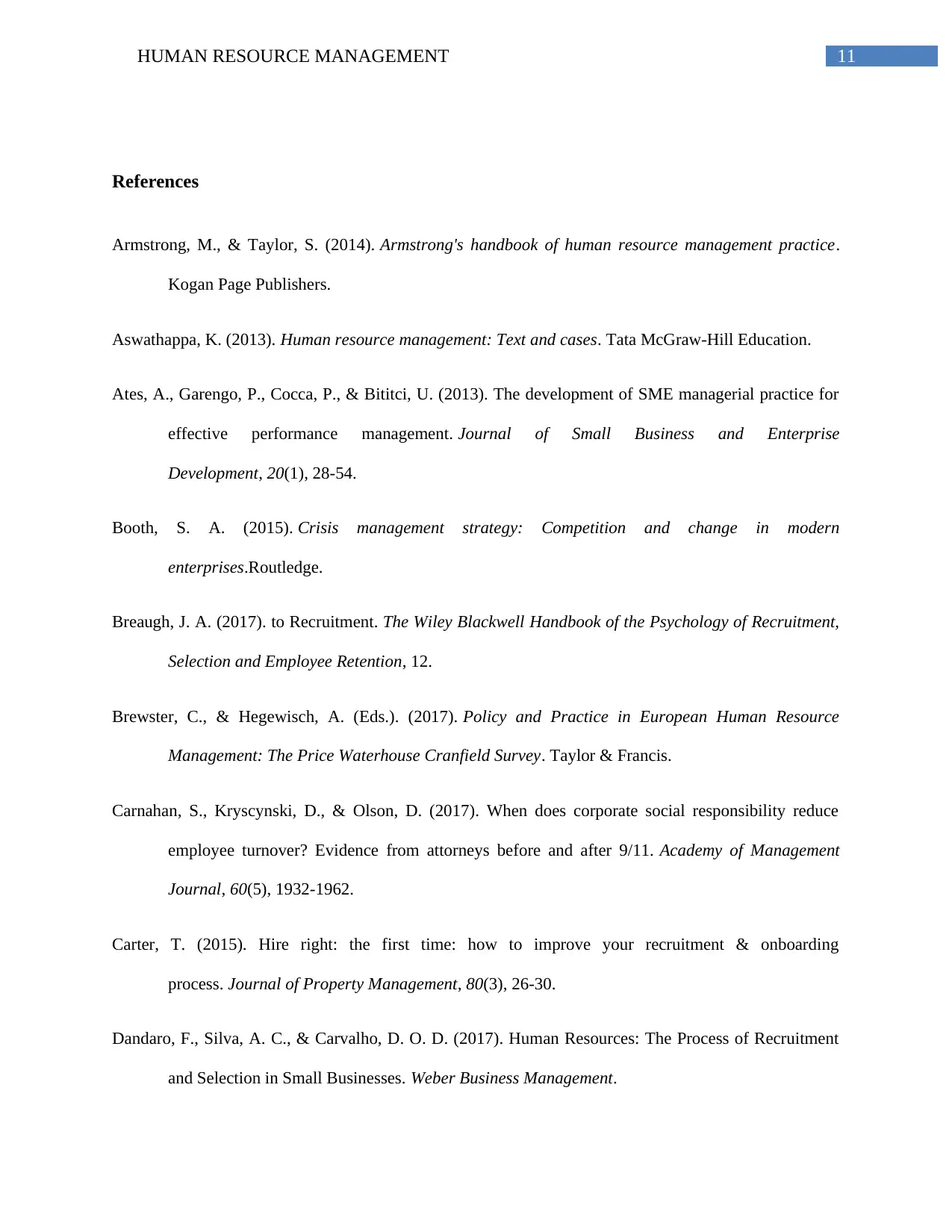
11HUMAN RESOURCE MANAGEMENT
References
Armstrong, M., & Taylor, S. (2014). Armstrong's handbook of human resource management practice.
Kogan Page Publishers.
Aswathappa, K. (2013). Human resource management: Text and cases. Tata McGraw-Hill Education.
Ates, A., Garengo, P., Cocca, P., & Bititci, U. (2013). The development of SME managerial practice for
effective performance management. Journal of Small Business and Enterprise
Development, 20(1), 28-54.
Booth, S. A. (2015). Crisis management strategy: Competition and change in modern
enterprises.Routledge.
Breaugh, J. A. (2017). to Recruitment. The Wiley Blackwell Handbook of the Psychology of Recruitment,
Selection and Employee Retention, 12.
Brewster, C., & Hegewisch, A. (Eds.). (2017). Policy and Practice in European Human Resource
Management: The Price Waterhouse Cranfield Survey. Taylor & Francis.
Carnahan, S., Kryscynski, D., & Olson, D. (2017). When does corporate social responsibility reduce
employee turnover? Evidence from attorneys before and after 9/11. Academy of Management
Journal, 60(5), 1932-1962.
Carter, T. (2015). Hire right: the first time: how to improve your recruitment & onboarding
process. Journal of Property Management, 80(3), 26-30.
Dandaro, F., Silva, A. C., & Carvalho, D. O. D. (2017). Human Resources: The Process of Recruitment
and Selection in Small Businesses. Weber Business Management.
References
Armstrong, M., & Taylor, S. (2014). Armstrong's handbook of human resource management practice.
Kogan Page Publishers.
Aswathappa, K. (2013). Human resource management: Text and cases. Tata McGraw-Hill Education.
Ates, A., Garengo, P., Cocca, P., & Bititci, U. (2013). The development of SME managerial practice for
effective performance management. Journal of Small Business and Enterprise
Development, 20(1), 28-54.
Booth, S. A. (2015). Crisis management strategy: Competition and change in modern
enterprises.Routledge.
Breaugh, J. A. (2017). to Recruitment. The Wiley Blackwell Handbook of the Psychology of Recruitment,
Selection and Employee Retention, 12.
Brewster, C., & Hegewisch, A. (Eds.). (2017). Policy and Practice in European Human Resource
Management: The Price Waterhouse Cranfield Survey. Taylor & Francis.
Carnahan, S., Kryscynski, D., & Olson, D. (2017). When does corporate social responsibility reduce
employee turnover? Evidence from attorneys before and after 9/11. Academy of Management
Journal, 60(5), 1932-1962.
Carter, T. (2015). Hire right: the first time: how to improve your recruitment & onboarding
process. Journal of Property Management, 80(3), 26-30.
Dandaro, F., Silva, A. C., & Carvalho, D. O. D. (2017). Human Resources: The Process of Recruitment
and Selection in Small Businesses. Weber Business Management.
⊘ This is a preview!⊘
Do you want full access?
Subscribe today to unlock all pages.

Trusted by 1+ million students worldwide
1 out of 14
Related Documents
Your All-in-One AI-Powered Toolkit for Academic Success.
+13062052269
info@desklib.com
Available 24*7 on WhatsApp / Email
![[object Object]](/_next/static/media/star-bottom.7253800d.svg)
Unlock your academic potential
Copyright © 2020–2025 A2Z Services. All Rights Reserved. Developed and managed by ZUCOL.




